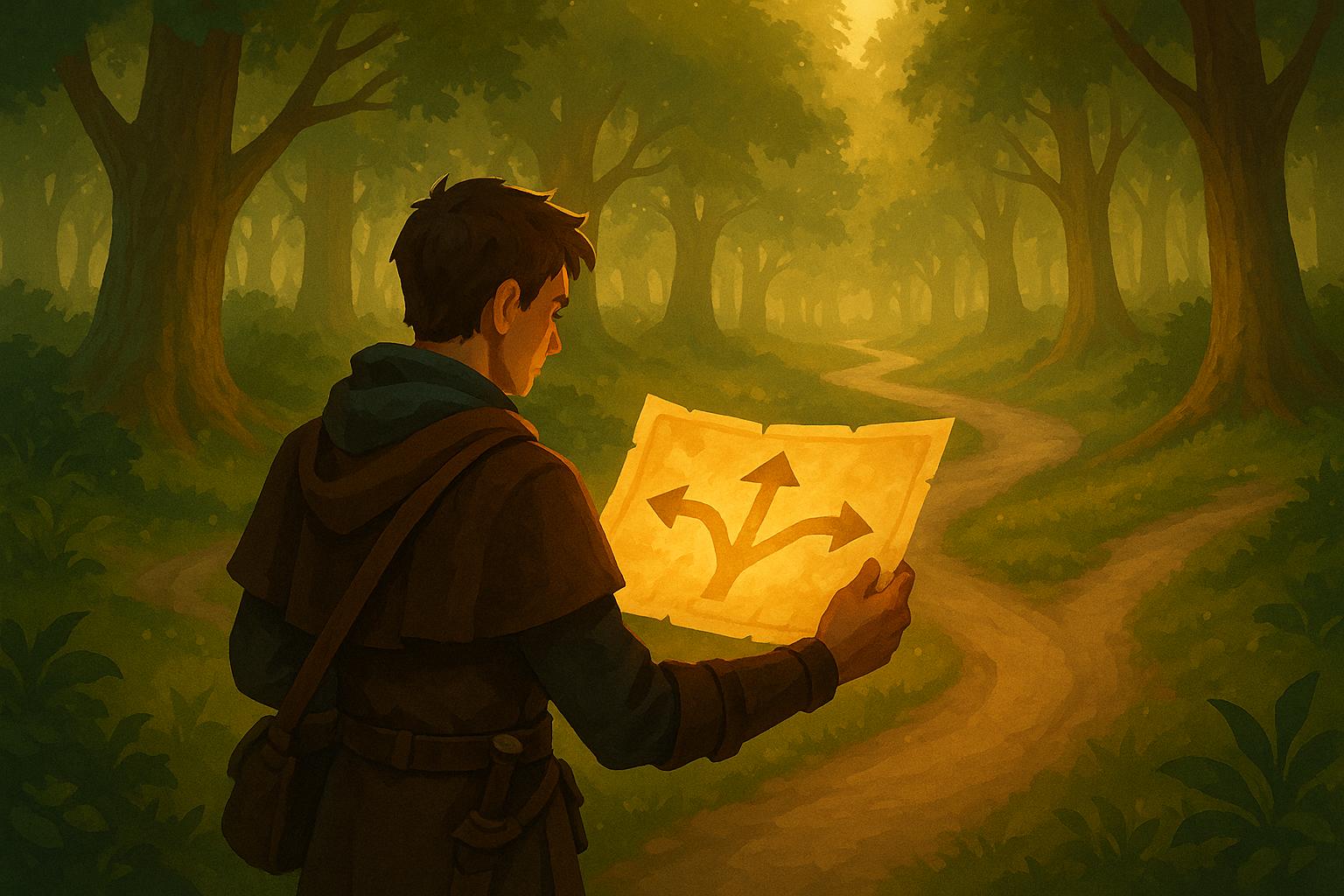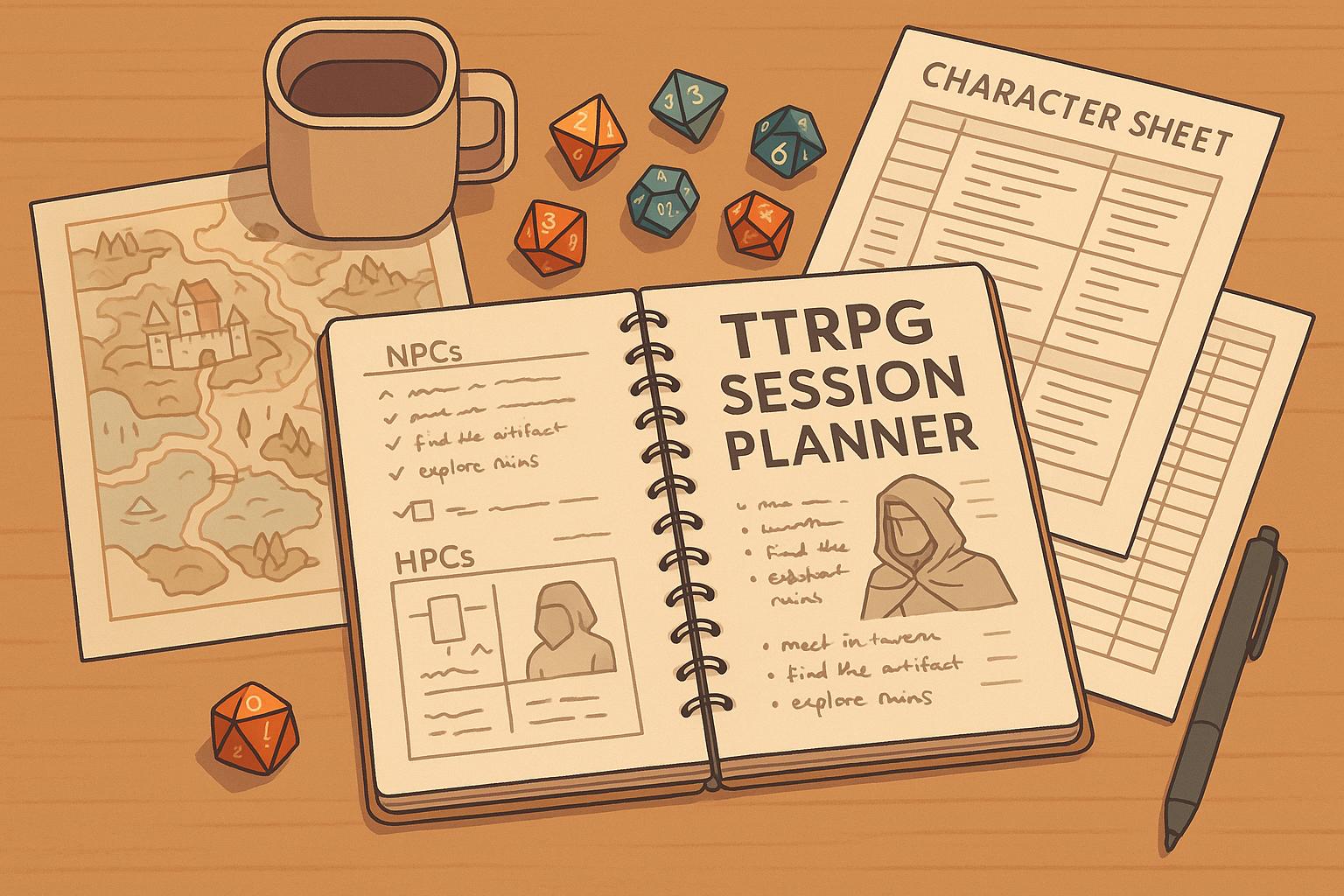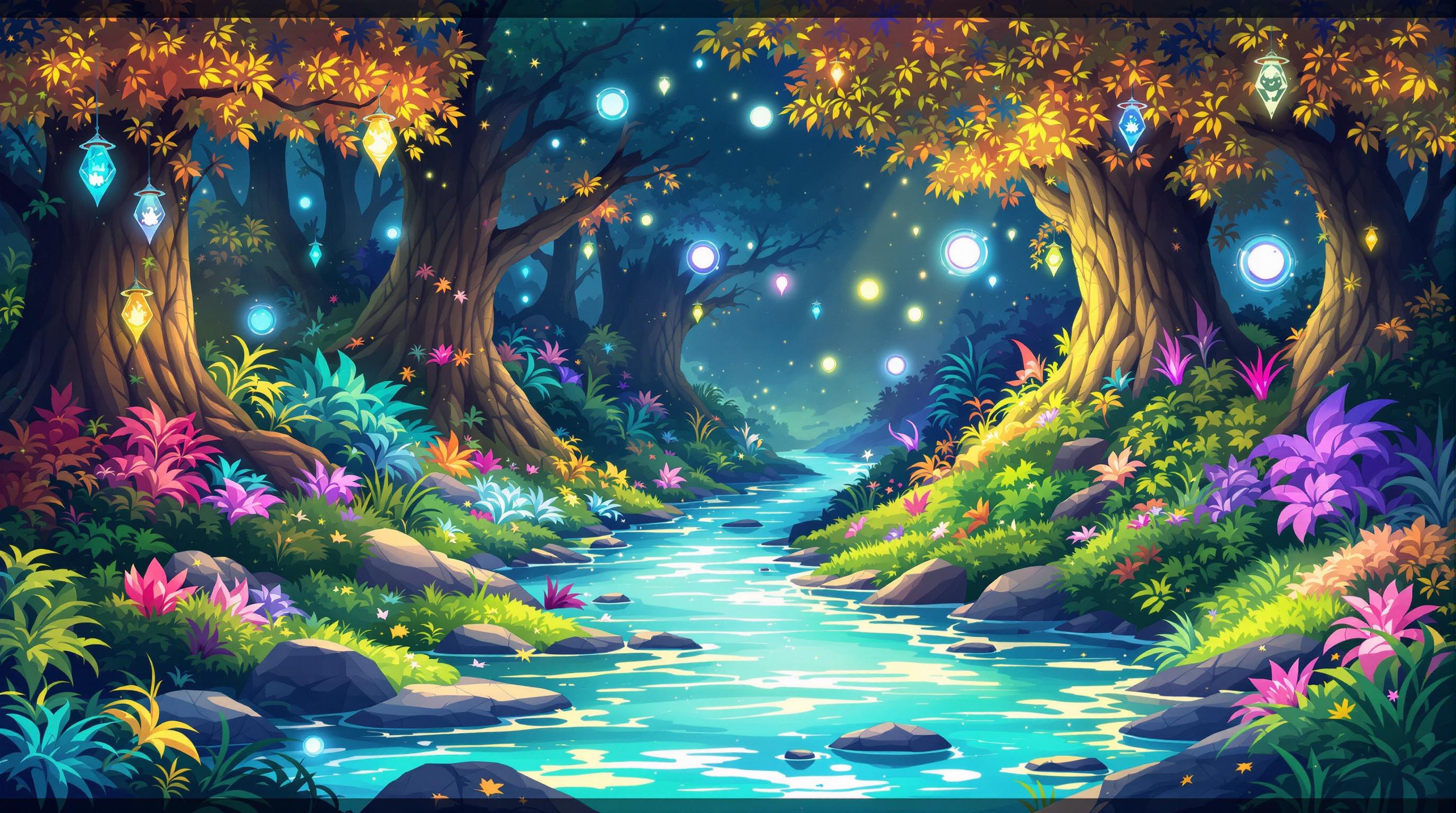Choosing between survival horror and survival sandbox RPGs depends on your group's preferences. Survival horror emphasizes fear, limited resources, and structured storytelling, creating tension and vulnerability. Survival sandbox focuses on player freedom, open-world exploration, and resource management, encouraging self-directed adventures.
Key Differences:
- Survival Horror: Linear story, resource scarcity, psychological tension, and guided gameplay.
- Survival Sandbox: Open-ended gameplay, player-driven narratives, crafting, and long-term planning.
Quick Tip: Discuss with your group - do they prefer structured, tense experiences or open, flexible worlds? Test both with one-shot sessions to find the best fit.
Tabletop Horror RPGs| Pros and Cons of RPG Genres
What Are Survival Horror Tabletop RPGs?
Survival horror tabletop RPGs are all about creating a sense of fear, tension, and psychological unease for players. Unlike games where heroes boldly charge into battle, these experiences are built around vulnerability. Characters are deliberately underpowered, making brute force an unreliable solution. Instead, players must think strategically, make tough decisions, and manage limited resources to stay alive. The dice rolls add an unpredictable element, ensuring that survival is never guaranteed. The focus shifts from action-packed heroics to immersive storytelling, where the journey and atmosphere take center stage. This approach echoes H.P. Lovecraft’s famous observation:
"The oldest and strongest emotion of mankind is fear, and the oldest and strongest kind of fear is fear of the unknown."
How Survival Horror Games Work
Survival horror RPGs use specific mechanics to heighten the sense of dread and helplessness. Players often face scenarios where resources like ammunition, healing items, or even basic supplies are scarce. These limitations force difficult, high-stakes decisions that can mean the difference between life and death.
Many of these games also feature systems for tracking sanity or stress, reflecting the psychological toll of encountering the bizarre or terrifying. As characters witness horrors or face impossible odds, their mental stability can crumble, adding another layer of tension. Players must juggle both physical survival and the mental well-being of their characters.
The dice mechanics further intensify the experience. Even the most skilled characters are vulnerable to failure, and a single bad roll can lead to disastrous consequences. This unpredictability keeps the stakes high and ensures that danger always feels immediate.
Mood and Setting in Survival Horror
The mechanics of survival horror games are only half the story - the mood and setting are just as crucial. These games thrive on isolation and the fear of the unknown. Players often find themselves cut off from any outside help, facing threats they can’t fully understand.
"Horror RPGs are not just about monsters and gore - they are about atmosphere, psychology, and storytelling techniques that create an unforgettable experience." – Bounty Hunter
Rather than relying on gore or cheap scares, survival horror leans into psychological tension. Themes like paranoia, loss of control, and creeping dread unfold gradually, as game masters reveal details piece by piece. This slow build of uncertainty keeps players on edge.
"Fear thrives in uncertainty. Don't give all the answers too soon - let players wonder. A half-seen creature is always scarier than one fully revealed." – Bounty Hunter
The setting itself plays a pivotal role, almost becoming a character in the story. Whether it’s a crumbling mansion, a desolate research facility, or a foggy, abandoned town, the environment actively works against the characters. Strange noises, shifting shadows, and unexplained occurrences keep the tension high without relying solely on direct confrontations.
Call of Cthulhu Example
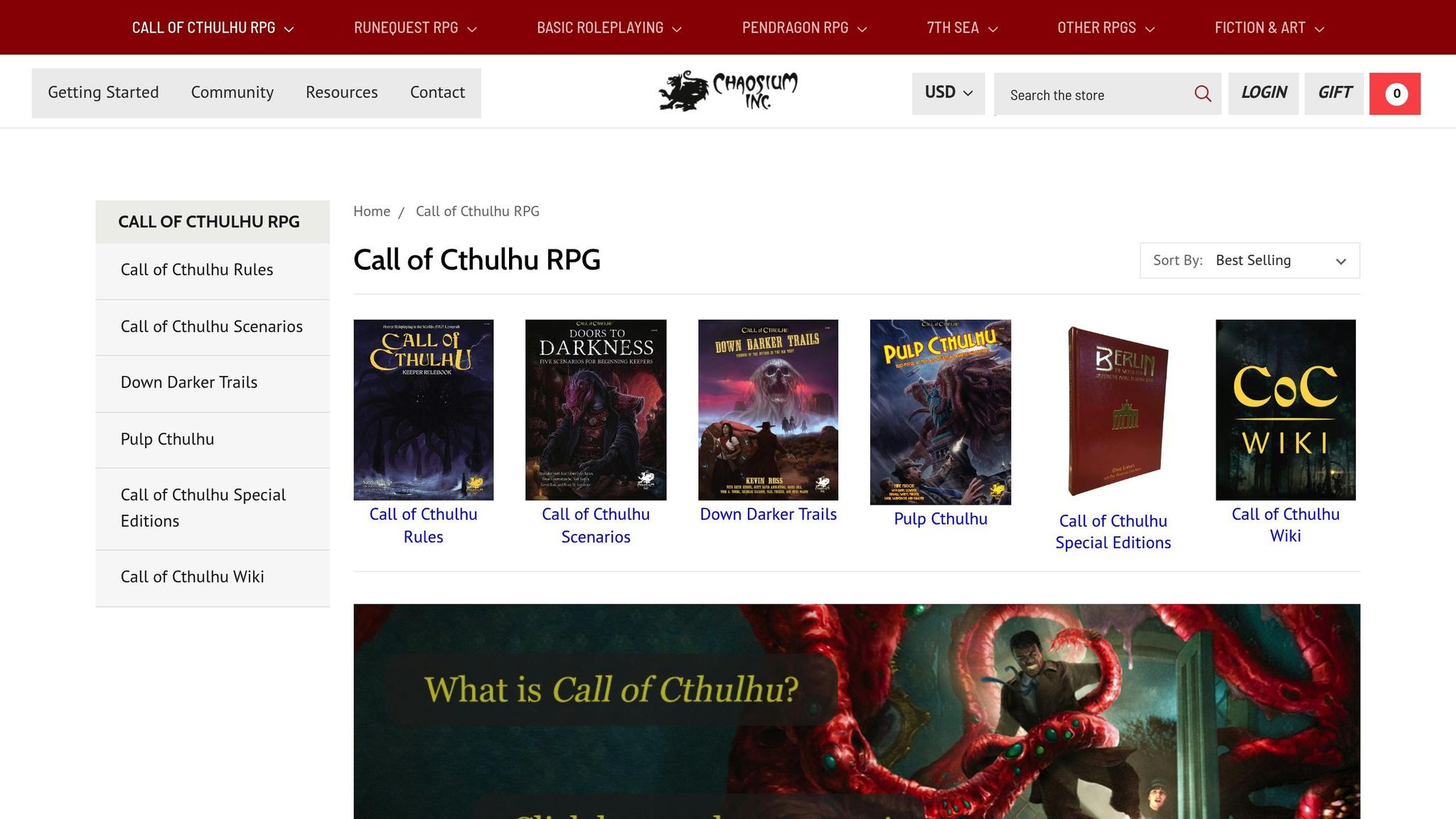
One of the best-known examples of survival horror tabletop RPGs is Call of Cthulhu. Inspired by H.P. Lovecraft’s cosmic horror, this game casts players as investigators who delve into mysteries that threaten both their sanity and their lives.
The game’s Sanity system is a key feature, tracking characters’ mental health as they encounter otherworldly horrors. Witnessing a monster or uncovering forbidden knowledge can result in significant Sanity loss, creating a dynamic where the pursuit of truth comes at a steep personal cost.
Combat in Call of Cthulhu is rarely a viable option. Investigators are often ordinary people with limited fighting skills, so they must rely on hiding, fleeing, or outsmarting their foes. This forces players to think creatively, as direct confrontation usually ends in disaster.
Gameplay revolves around investigation. Players spend much of their time researching, conducting interviews, and piecing together clues. Libraries and archives are as critical as any weapon, as the characters slowly unravel conspiracies that stretch across decades - or even centuries. Each new discovery brings them closer to the truth, but also closer to madness, perfectly capturing the delicate balance between knowledge and survival.
What Are Survival Sandbox Tabletop RPGs?
Survival sandbox tabletop RPGs offer a different experience compared to survival horror games. While survival horror tends to follow a set storyline, focusing on tension and resource scarcity, sandbox games prioritize player freedom and exploration. In these games, players create their own narratives within an open, self-sustaining world.
At the heart of survival sandbox games is the concept of player agency - how much control players have over their characters and the game's unfolding events. Unlike the structured plots of survival horror, sandbox games give players the tools and systems to shape their own adventures. Instead of leading players down a specific path, these games encourage creativity, letting players turn the game world into a space for experimentation and expression. Let’s dive into the mechanics that make these player-driven worlds tick.
How Survival Sandbox Games Work
The gameplay in survival sandbox RPGs revolves around gathering resources, crafting, and building bases - all of which demand problem-solving and teamwork. Players explore expansive territories, collect materials, and construct everything from basic shelters to elaborate strongholds. These mechanics foster emergent gameplay, allowing players to set their own goals and approach challenges in unique ways.
Resource management is a cornerstone of these games. Unlike survival horror, where scarcity heightens tension, sandbox games treat resources as tools for growth and development. Players start with minimal supplies and work toward creating thriving settlements or advanced gear. Crafting systems often include a variety of recipes and upgrade paths, rewarding creative thinking and offering multiple ways to solve problems.
Base building adds another layer of strategy. Players must carefully choose locations, plan defenses, and consider access to resources and future growth. Each decision can have lasting effects on the campaign, making planning and foresight key components of success.
Mood and Setting in Survival Sandbox
The atmosphere in survival sandbox games is all about flexibility, strategy, and progress driven by the players themselves. Instead of the tight, nerve-wracking tension found in survival horror, these games evoke a sense of possibility and exploration. The world feels alive and reactive, with player actions leading to meaningful changes.
Exploration is a major focus. Players decide where to go, what challenges to face, and which opportunities to pursue, creating an experience centered on discovery and imagination rather than scripted scares.
Teamwork plays a big role, too. Survival sandbox games encourage collaboration, as players pool resources, tackle challenges together, and build expansive settlements. This shared effort creates a collective narrative that goes beyond individual achievements.
Long-term planning is essential. Groups must balance immediate needs, like food and shelter, with longer-term goals, such as fortifying a base or exploring new regions. Strategic decisions - whether to stockpile resources or invest in upgrades - keep players engaged across multiple sessions.
Mutant: Year Zero Example
Mutant: Year Zero is a standout example of a survival sandbox RPG. Set in a post-apocalyptic world, players take on the roles of mutants emerging from underground shelters. The game blends flexible character progression, collaborative world-building, and self-directed goals.
Its zone exploration system is a hallmark of sandbox design. Players choose which parts of the wasteland to explore, with each zone offering unique resources, risks, and opportunities. Instead of being forced along a specific path, the world reacts dynamically to player decisions.
Character development in Mutant: Year Zero reflects the freedom of sandbox games. There are no rigid class systems - characters evolve based on player choices and in-game events. Mutations develop naturally during gameplay, resulting in unique builds shaped by the players’ actions.
The Ark system highlights the collaborative base-building aspect. Players work together to expand and improve their underground community, making decisions about priorities like enhancing defenses, increasing food supplies, or building workshops for crafting advanced tools. These choices influence both individual characters and the group’s future.
While the game maintains a sense of tension, it avoids the overwhelming despair often found in survival horror. Players retain a sense of control and agency through dynamic resource opportunities, whether by gathering materials, trading with other settlements, or finding new ways to sustain their community. This balance keeps the game engaging while empowering players to shape their own story.
Survival Horror vs Survival Sandbox: Key Differences
While survival horror and survival sandbox RPGs share some core survival mechanics, they differ significantly in storytelling, resource management, and player control. Let’s break down how these genres diverge in their approach to gameplay and narrative.
Game Rules and Story Differences
The most striking difference lies in how the story unfolds and the level of freedom given to players. Survival horror games stick to a tightly controlled, linear narrative, often revealed through in-game journals, audio logs, or other storytelling devices. These games take players on a structured journey with a clear beginning, middle, and end, leaving little room for deviation from the main plot. In this setup, the game’s creators maintain firm control over the story’s flow, limiting player choices to align with the predetermined storyline.
On the flip side, survival sandbox games throw out the rulebook when it comes to storytelling. Instead of guiding players through a set plot, these games encourage them to craft their own stories through emergent gameplay. Game designer Ernest Adams describes this approach as:
"in sandbox storytelling, the idea is to give the player a big open world populated with opportunities for interesting interactions ... in any order"
This distinction leads to vastly different gameplay experiences:
| Aspect | Survival Horror | Survival Sandbox |
|---|---|---|
| Story Structure | Linear, fixed narrative with defined progression | Open-ended, player-driven with emergent storytelling |
| Player Control | Limited, within a controlled narrative framework | High, allowing for creative exploration and decision-making |
| Resource Focus | Scarcity drives tension and strategic decisions | Resources enable crafting and creative problem-solving |
| Atmosphere | Tense, eerie, and emphasizes vulnerability | Exploratory, encouraging strategic and creative thinking |
| Replay Value | Variations within a fixed narrative | Endless possibilities through open-world exploration |
Survival horror thrives on scarcity. Resources like ammunition and health are intentionally limited, creating a constant sense of tension and forcing players to make tough decisions about when and how to use them. As author Neal Vincent explains:
"Survival horror is a more specific sub-genre of horror game that's usually defined by a scarcity of resources and some element of 'struggle against the odds.'"
In contrast, survival sandbox games focus on giving players the freedom to experiment and create. Resources are less about survival anxiety and more about enabling creativity. Players often set their own goals or work toward broad objectives, making each playthrough unique.
Character Growth and Risk Systems
The two genres also differ in how they handle character progression and risk. In survival horror, combat is often de-emphasized. Instead, players rely on evasion, puzzle-solving, and careful resource management. Characters are intentionally kept vulnerable, with limited weapons and supplies, which forces players to think strategically rather than rely on brute force. The risk system revolves around conserving scarce resources like ammunition and health items, making every decision critical.
Survival sandbox games, however, embrace open-world exploration and player-driven progression. Characters can grow stronger through skill development, gear crafting, and resource gathering. Instead of constant vulnerability, players can build up their characters and even collaborate with others to achieve greater goals.
Risk and reward systems also vary between the two genres. In survival horror, players are stripped of power, making every encounter a high-stakes balancing act where strategy and conservation are key. In survival sandbox games, risk often comes from venturing into unknown areas or dealing with the unpredictable nature of the open world. Crafting systems allow players to combine resources into new items, adding an element of creativity to survival. Some sandbox games even include permadeath, where losing a character means starting over entirely. This mechanic heightens the stakes and adds an extra layer of challenge.
sbb-itb-b8b00a5
Which Genre Fits Your Gaming Group?
Picking between survival horror and survival sandbox isn't just about what sounds fun - it’s about understanding your group’s playstyle. A mismatch can kill the vibe and leave players disengaged. But when the genre aligns with your group’s dynamics, you’re setting the stage for unforgettable game nights that everyone will look forward to. Think of it as ensuring the mechanics and story challenges complement your group’s unique energy.
Know Your Group's Gaming Style
Your group’s gaming style is the key to finding the right genre. Some players are drawn to narrative-heavy RPGs, where roleplaying and storytelling take center stage. These groups often enjoy survival horror, where a structured narrative allows for deep character arcs and emotional storytelling.
On the flip side, some groups favor “crunchy” systems - games packed with intricate mechanics that reward tactical thinking. These players thrive on mastering rules and strategies, making survival sandbox games a great fit. These games offer open-ended exploration, resource management, and crafting systems that reward careful planning and mechanical expertise.
How your group approaches exploration also matters. For some, exploration is about immersing themselves in a story-rich world, like stepping into the pages of a gripping fantasy novel. If this sounds like your group, survival horror’s structured gameplay might be the way to go.
If your group sees exploration as a chance for creative problem-solving and emergent storytelling, survival sandbox games are likely a better match. These systems encourage players to shape the game world through their choices, offering the freedom to create unique scenarios and interactions within an open environment.
With these differences in mind, it’s worth asking a few targeted questions to figure out which genre will resonate most with your group.
Questions to Help Your Group Decide
Before diving into a campaign, take some time to chat with your group about their preferences. Here are a few questions to guide the discussion:
How does your group handle tension and risk?
Does your group thrive on the intense, immediate pressure of survival horror - limited resources, lurking threats, and the constant fear of the unknown? Or do they prefer the slow-burn challenge of survival sandbox games, where tension builds through long-term planning and resource management?
How much control does your group want over the story?
Player agency is all about how much freedom the group has to influence the game world and narrative. Some groups enjoy the immersive experience of a guided story with defined character arcs, while others prefer the open-ended freedom to make choices that lead to wildly different outcomes.
Ask your group if they’d rather explore a world where their decisions matter within a pre-set framework or if they’d enjoy shaping the story themselves.
How comfortable is your group with open-ended narratives?
Survival sandbox games demand player initiative and a willingness to embrace emergent storytelling. While some players love this freedom, others might feel overwhelmed by the lack of structure. Too many restrictions can stifle creativity, but too much freedom can lead to a chaotic or fragmented experience.
What’s your group’s experience level with tabletop RPGs?
For newer players, survival horror’s structured approach - with clear objectives and guided progression - might feel more accessible. On the other hand, seasoned players may appreciate the creative freedom and complexity of survival sandbox games.
Ultimately, honest communication is the foundation of a successful game. Talk openly with your group about their preferences, and collaborate to create characters that will thrive in your chosen genre. These conversations will help you choose a survival experience that’s perfectly tailored to your table.
Find Games with TTRPG Games Directory
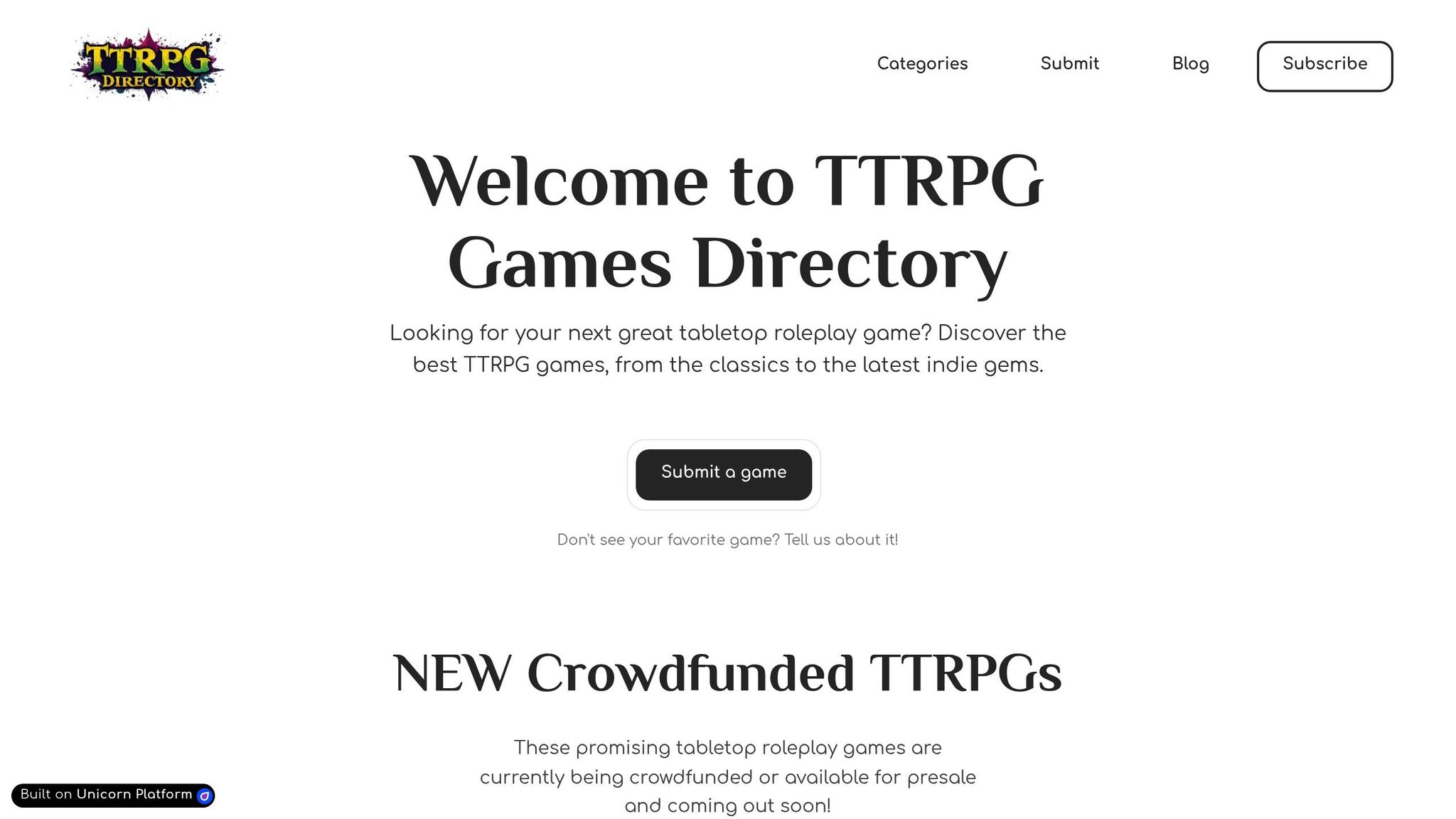
Once you've settled on a genre, the next step is finding a tabletop RPG that aligns with your group's preferences. The TTRPG Games Directory simplifies this process by categorizing hundreds of games and offering detailed filters to match your group's style.
Instead of spending hours sifting through forums or reviews, you can explore curated collections that highlight games with unique mechanics and settings. This makes it easier to uncover hidden gems that you might not have encountered otherwise.
Browse Games by Genre and Style
The TTRPG Games Directory organizes games into popular genres like Fantasy, Science Fiction, Horror, and Post-Apocalyptic, helping you quickly narrow down options based on your preferred setting. For instance, fans of survival horror can explore the Horror and Cosmic Horror categories, which focus on intense, tension-filled experiences. Meanwhile, those who enjoy survival sandbox gameplay should check the Post-Apocalyptic and Science Fiction sections.
Each game listing includes detailed descriptions, covering mechanics, themes, and standout features. This allows you to gauge whether a game leans more toward narrative-driven horror or open-ended exploration before making a commitment. If your group is drawn to the structured tension of survival horror, you can filter for games that emphasize guided storytelling and atmospheric dread. On the other hand, if they prefer the creative freedom of sandbox-style survival, you can search for titles featuring resource management, crafting systems, and emergent gameplay.
The directory also helps you assess the complexity of different games. Some survival horror systems are designed with simple rules, making them accessible for new players who want to focus on the story. Others feature intricate mechanics, catering to experienced groups that enjoy tactical depth. Similarly, survival sandbox games range from beginner-friendly systems to elaborate simulations that reward strategic planning and mechanical expertise. These clear distinctions make it easier to find a game that suits your group's skill level and interests.
Find Popular and Independent RPGs
The directory features a mix of well-known RPGs and indie titles. This ensures you can find something that fits your group's needs, whether you're looking for a widely recognized system with a robust community or a lesser-known indie game offering a fresh perspective.
Among the survival TTRPGs listed are Alien RPG, Forbidden Lands, and Mothership. Each of these games showcases a different approach to survival gameplay. For example, Alien RPG focuses on claustrophobic, corporate-driven horror, while Forbidden Lands emphasizes open-world exploration. By comparing these varied design philosophies, you can choose a game that resonates most with your group.
Well-established games often come with comprehensive rulebooks, official expansions, and active online communities that provide support and inspiration. Indie games, on the other hand, frequently introduce fresh mechanics or innovative twists on familiar genres, offering something new to spice up your gaming sessions.
To keep you in the loop, the directory sends out a weekly newsletter featuring the top 10 TTRPG games recently added. This newsletter highlights new releases, such as newly translated survival horror games or inventive indie sandbox systems, ensuring you're always up to date with the latest additions to the tabletop RPG world.
Conclusion: Pick the Right Genre for Your Table
Deciding between survival horror and survival sandbox RPGs is all about knowing what excites your group. Survival horror thrives on gripping narratives and a sense of dread, perfect for players who enjoy clear goals and the thrill of overcoming obstacles through strategy and resource management. On the other hand, survival sandbox games shine when your group loves open-ended exploration and creative problem-solving.
Think about what your group enjoys most - whether it’s tactical combat, deep character drama, or collaborative storytelling. Also, consider the energy and enthusiasm both players and the Game Master bring to the table. These factors can guide you toward the genre that best suits your group’s dynamic.
To make this choice easier, the TTRPG Games Directory is a fantastic resource. It organizes games by genre and style, offering detailed descriptions that highlight whether a system leans into the structured tension of survival horror or the open-ended creativity of sandbox gameplay. The directory includes a mix of well-known titles and indie gems, making it easy to find something that matches your group’s interests and experience level.
If you’re unsure, try both genres with one-shot sessions before committing to a full campaign. These short sessions can help you gauge which style resonates most with your group. Whether you’re drawn to the chilling atmosphere of survival horror or the boundless creativity of sandbox adventures, the right genre can elevate your group’s storytelling to new heights.
FAQs
How do I decide if my group would prefer a survival horror or survival sandbox RPG?
To figure out which RPG style matches your group's vibe, start by considering what gets them most excited during gameplay. Are they drawn to tense, story-heavy adventures filled with suspense and atmosphere? If yes, survival horror might be the way to go. But if your group thrives on open-world exploration, creative problem-solving, and crafting their own narratives, a survival sandbox RPG could be a better fit.
Also, think about how much structure they like. Groups that enjoy clear goals and high-pressure scenarios will likely lean toward survival horror. Meanwhile, those who enjoy flexibility, improvisation, and building their own worlds might find survival sandbox games more their speed.
How can I balance resource management and player freedom in survival sandbox RPGs?
To strike a balance between managing resources and granting player freedom in survival sandbox RPGs, it’s essential to develop a system that encourages smart decision-making. Introduce scarcity for critical resources, but give players a variety of options to obtain them - like trading, scavenging, or crafting. This approach keeps resource management interesting without making it feel overly punishing.
At the same time, give players the power to make impactful choices with clear consequences. For instance, let them decide whether to focus on immediate survival or invest in strategies for the long haul. By offering this kind of flexibility and tailoring challenges to their actions, you can preserve a sense of control while ensuring the survival mechanics remain engaging.
How do survival horror RPGs keep players engaged and maintain suspense over multiple sessions?
Survival horror RPGs have a knack for pulling players in by crafting an atmosphere thick with suspense and fear. These games thrive on mechanics like limited resources, high-stakes decisions, and threats that can strike when least expected. The storytelling often leans into eerie mysteries, psychological twists, and moments of doubt, all designed to keep players on edge.
To maintain that gripping tension over time, these games master the art of pacing. They skillfully alternate between heart-pounding encounters and quieter, ominous lulls. This ebb and flow of intensity keeps players deeply engaged and emotionally tied to the unfolding narrative.
